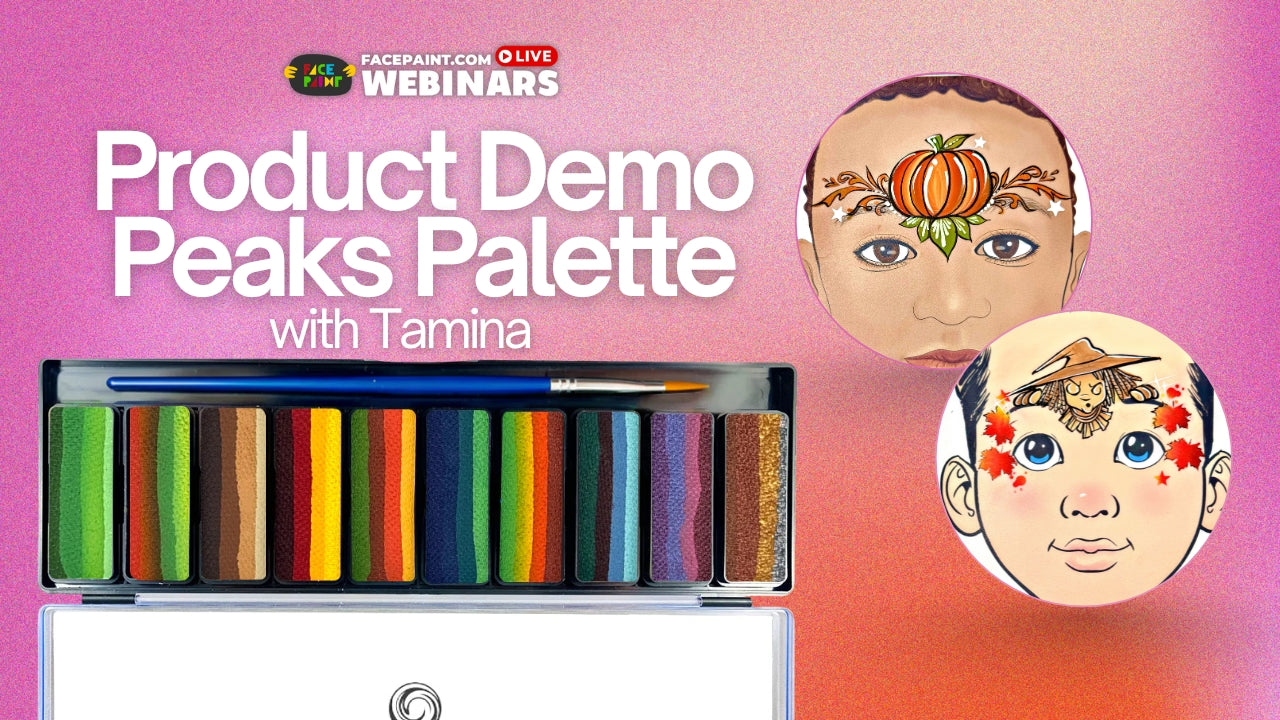A subject that often comes up in the face painting groups is how to choose colors and brands that will give you good coverage for varying skin tones. The root of this issue isn’t as much the skin tone underneath the face paint as it is the qualities of various pigments and paints which make them either opaque or sheer.
Some colors tend to be more sheer than others
Many acrylic paints, which are used on canvas (and should never be used on skin), have tiny print on the back of each tube of color which alerts the artist as to whether the paint is opaque, translucent, or transparent. In face paint, this information is not listed on each color, but the issues of opacity versus transparency are very similar. Yellows, oranges, reds, and dark blues tend to be more sheer, with the result being that some colors and pigments are better able to give good coverage than others. This does vary with different types of face paint (wax-based versus glycerin-based or regular finish versus metallic) and from brand to brand, which is why most face painters use a variety of paints.
In this post, we’ll look at several common brands and types of paint to see how well they cover light or dark skin. By knowing their weaknesses and strengths, you should be better able to create designs which satisfy your customers.
On these two first examples, I used Paradise, which is a glycerin-based face paint. Paradise goes on creamy and is very comfortable to wear on your face. It never feels tight as it dries, but retains its creamy quality on the skin. The trade-off is that it tends to not be quite as durable in sweaty conditions or as brilliant as some of the wax-based paints.
As you can see in the image below, when placed on the darker skin tone, the colors which cover the least are the yellow and orange. Although the red and dark blue don’t cover perfectly, because they are dark colors on a darker skin tone, their sheer qualities aren’t as obvious.
Here are the same colors applied to a lighter skin tone. If you look closely, you realize that the yellow and orange don’t cover much better than they did on the darker skin tone, but it’s not as obvious because the skin underneath is lighter. However, it is obvious that the dark blue and the dark purple do not cover well. They have sheer tendencies which are revealed by the lighter skin. If you don’t apply a second coat after the first has dried, they can look streaky on fair skin.
Metallics or pearls stand out dramatically on dark skin tones
In the next images, I used metallics and pearls from TAG, Paradise, and Kryvaline. While the metallic or pearls are more sheer, they still stand out beautifully on the dark skin tone, making them a good choice when trying to get complete coverage on dark skin.

On the lighter skin tone, the pearls (metallics) don’t have as much dramatic appeal, although they’re still pretty. Especially for the darker colors, you can definitely see the skin through them, so when they’re applied to large areas, the result can be a streaky look which will again require more than one coat for good coverage.
The final two photos are examples of Global face paints, with the exception of the white and black, which are Diamond FX, a wax-based face paint. Global is known for vibrant colors which wash off easily. Diamond FX, like Wolfe, is a great choice for black and white as it covers everything well and is easy to apply in clean, crisp lines with a brush.
The coverage with Global was quite good on both the dark and light skin tones, with the weak area for dark skin showing up again in the yellow and the weak colors on light skin being the dark blue and dark purple.
How do we deal with the problems in getting good coverage?
No type of paint will cover perfectly over every color of skin. All have strengths and weaknesses revealed by the skin tone beneath. By understanding these strengths and weaknesses, however, there are ways to balance them so you will produce better results while face painting. Here are some suggestions.
1. Use a sponge rather than a brush to apply paint to large areas
Sometimes just using a different tool to apply the paint will help your coverage. A brush pulls the paint across the surface of the skin, which can leave a thin layer prone to streaking, while a sponge deposits paint by dabbing. A well-loaded sponge which is not too wet may provide a more even layer of paint than you will get with a brush, so experiment with this to see if it’s a better solution for whatever design you’re doing at the moment. If you must apply a second coat, always wait until the first one is dry before putting the second one over the top.
2. Combine a metallic with your regular face paint to get the best qualities of both
No matter what you do, yellow is going to be fairly sheer. Because yellow is a light color, this weakness in the paint will be exposed by darker skin. To compensate, use a metallic yellow combined with the regular yellow. The metallic also tends to be sheer, but because it is more light reflective, it shows up well on darker skin.
3. Combine light sheer colors with a highly opaque color such as white
Diamond FX white or Wolfe white are highly opaque colors. When you combine them with a light color, such as yellow, it softens the yellow, but it also gives it far more opacity. While there is a trade-0ff 0f intensity for opacity, for some designs this may be your best solution.
4. Give yourself enough time to mix the water into your paints well so you pick up enough pigment to cover the skin
This tip came from a workshop I attended which was taught by Olga Murasev (Maleca). She said that sometimes face painters don’t mix water into their paints well enough before using them. The result is that there isn’t enough pigment in the brush to give a complete coat over the skin beneath. If you’re experiencing a problem with your paints appearing too sheer on the skin, try taking more time to mix water into your face paint before you apply it to the skin.
Keep in mind that a few insurance companies can be picky about mixing brands of face paints on the job, so check with your company to make sure they cover you even if you use more than one brand of face paint.
Happy painting!
Beth MacKinney is the owner of and primary face painter for Face Paint Pizzazz in the NW Chicago suburbs. She also writes blog posts and tutorials for Clownantics.com.
 FREE SHIPPING FOR USA ORDERS OVER $100
FREE SHIPPING FOR USA ORDERS OVER $100














Bob
August 27, 2018
Very helpful!